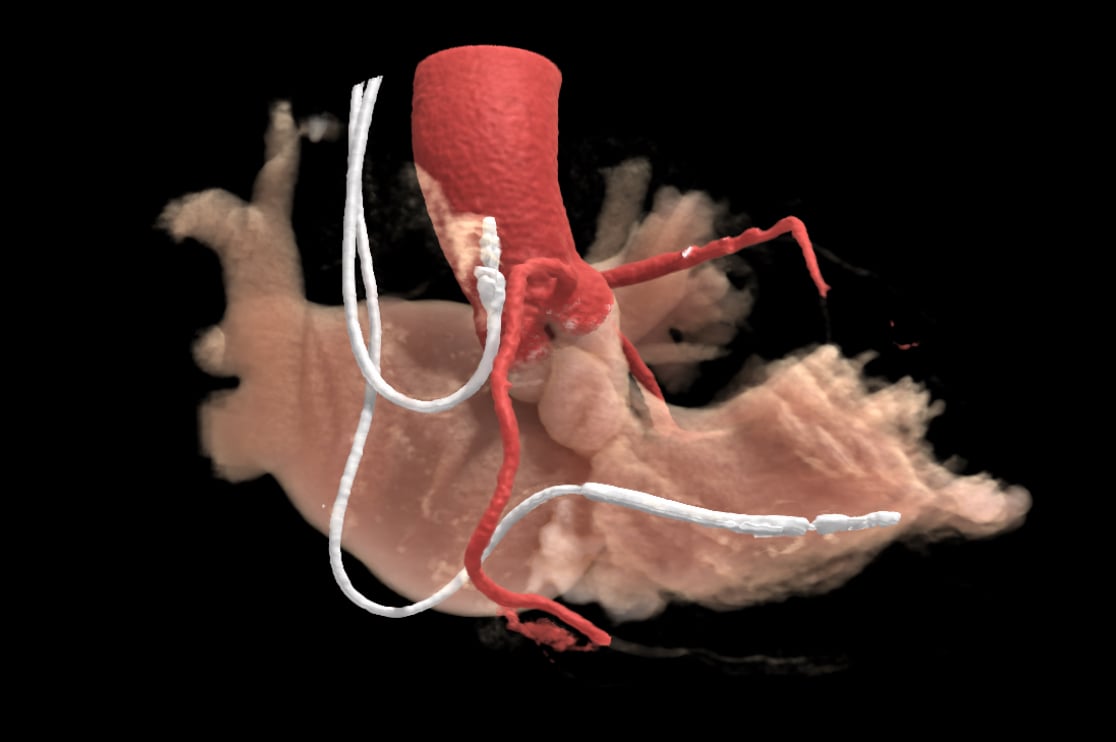
A cardiac CT of a patient with pacemaker leads, which can be challenging to get good images due to metal artifact. This image was rendered from using Canon's AiCE AI-assisted interactive reconstruction with Global Illumination 3-D rendering from a scan on an Aquilion One Genesis SP system.
There has been tremendous growth in the field of cardiovascular computed tomography (CT) in the past two decades, with more than 44,000 papers published since 2000. In the past year alone, there have been about 4,100 papers on cardiac CT. Below is the list of the top 9 most influential papers based on the impact on cardiology practice.
 The papers were selected and presented in brief during the Society of Cardiovascular CT (SCCT) virtual meeting in July by Todd Villines, M.D., FACC, FAHA, MSCCT, Julian Ruffin Beckwith Professor of Medicine, Division of Cardiovascular Medicine, University of Virginia, editor-in-chief of the Journal of Cardiovascular CT and SCCT past-president.
The papers were selected and presented in brief during the Society of Cardiovascular CT (SCCT) virtual meeting in July by Todd Villines, M.D., FACC, FAHA, MSCCT, Julian Ruffin Beckwith Professor of Medicine, Division of Cardiovascular Medicine, University of Virginia, editor-in-chief of the Journal of Cardiovascular CT and SCCT past-president.
He said CT angiography (CTA) has grown in importance over the past decade. This was highlighted in the 2019 European Society of Cardiology (ESC) guidelines, which made CTA the preferred test in patients with lower and intermediate ranges of coronary artery disease, with no previous diagnosis of coronary artery disease (CAD).
Villines outlines the following studies published in the past year as the most important regarding cardiac CT. He said they are in no particular order:
ISCHEMIA Trial — Initial Invasive or Conservative Strategy for Stable Coronary Disease.
This large, National Institutes of Health (NIH)-funded trial included more than 5,100 patients with moderate to severe ischemia who underwent functional testing.[1] About 50 percent of which had nuclear perfusion scans. Coronary CTA was used in most patients to rule-out left main CAD. The randomized trial used initial invasive revascularization vs. conservative medical strategy. About 79 percent were revascularized. No difference was seen between the two groups after three years in a five-point major adverse cardiac event (MACE) outcomes. It showed medical therapy should be used as the first line choice for most lower-risk patients.
Villines said this trial supports CTA as the front line test for patients without known CAD.
“Importantly, it highlights the potential role for anatomic testing. In fact, if you look at the results of ISCHEMIA, it was anatomy that predicted outcomes, ischemia did not. It teaches us that if we have a patient with moderate to severe ischemia on stress testing, perhaps sending them to the cath lab is not the best answer and they might be better served with CTA. It also shows that medical therapy is probably best for more of these patients,” Villines explained.
Read the related article ISCHEMIA Trial Results Find Interventions for Stable Heart Disease No better Than Drug Therapy.
PROMISE Trial: Age Sub-study
This 8,966 patient study evaluated test positivity and relationship to cardiovascular death and myocardial infarction (MI) according to age.[2] Test positivity was defined as a CTA with more than 70 percent stenosis, or more than 50 percent in the left main artery, or nuclear perfusion abnormality in at least one vessel territory.
The results showed patients under age 65 with a positive functional test was not associated with outcomes, but a CTA test with a calcium score above 100 was strongly associated with worse outcomes. Patients over the age of 65 with a positive functional test was more predictive, Villines said.
Read more on this study — CT Calcium Scoring Becoming a Key Risk Factor Assessment
Low-attenuation Plaque Using Machine Learning Superior for MI Prediction: SCOT-HEART
This study looked at low attenuation, non-calcified plaque on coronary computed tomography angiography (CCTA), which was shown to predict myocardial infarction (MI).[3] It included 1,769 patients with stable symptoms and coronary CTA. They were followed out to 4.7 years for MI. The CT images were analyzed by the Autoplaque 2.5 software from Cedars-Sinai, where a machine learning algorithm looked at the plaque burden and assigned a risk score, calcium score and calculated percent stenosis. The data show low attenuation plaque was the strongest predictor of MI, and patients had a five-fold increase in MI if it was above 4 percent.
“This highlights the potential of incorporating semi-automated plaque quantification into our evaluations,” Villines said.
CAD Severity on Cardiac CTA Identifies Patients With Most Benefit of Treating LDL Cholesterol
This study looked at CAD severity on cardiac CTA in 20,241 patients from the Western Denmark Heart Registry to identify which patients would benefit the most benefit if treated medically for LDL cholesterol according to ACC/AHA and ESC/EAS targets.[4] The study looked at the numbers needed to treat for six years to prevent atherosclerotic cardiovascular disease (ASCVD) events. The study showed in patients with no coronary plaque, there was no reason to treat them, while more attention might be paid to patients who have non-obstructive plaque and would benefit from statin therapy.
"This study really highlights the importance of CTA findings in dictating aggressiveness of medical therapy with regards to both statins and potentially even non-statin therapies," Villines said.
Coronary CTA Rule Out High-risk CAD in NSTEACS? The VERDICT Trial
The study used CTA to evaluate high-risk patients with non-ST-elevated acute coronary syndrome (NSTEACS).[5] Of the 1,023 patients in the study, 80 percent had elevated troponin, 40 percent had dynamic ECG changes and 24 percent had known CAD. Patients were scanned and either put into a CTA negative group, or a CTA positive or nondiagnostoc group. Both underwent diagnostic angiography to confirm the predictive value of CTA. What was shown was the close correlation of the negative predictive value of CTA.
Villines said the study shows a new era in coronary CTA. He explained the study showed over 90 percent negative predictive valve if there was no or only a little disease present. "It had very high sensitivity at nearly 97 percent, and one third of these patients turned out not to have significant coronary disease," Villines said. "This is a population we traditionally have not scanned but showed in some of these patients, but CTA was shown to be helpful in determining a management strategy for the patients."
Coronary CTA Rule Out in High-risk CAD in NSTEMI? The CARMENTA Trial
This study used an initial imaging-guided strategy versus routine care in patients with non-STEMI.[6] Patients were divided between three arms, one where catheter angiography was used first, one using cardiac MRI first and one using CTA first.
"What we saw was coronary CTA was able to safely defer about one-third of patients from going to the cath lab. The result was that it was safer to send the patient to CT rather than to the cath lab right away. Doing CTA before going to the cath lab actually had the lowest event rates," Villines explained.
Cardiac CT-based Mitral Annular Calcium Score and Valve-in-MAC Embolization
A cardiac CTA score was used to categorize mitral annular calcification (MAC) severity and predict valve embolization in patients who underwent transcatheter mitral valve replacement (TMVR) in a registry.[7] The 72-patient study showed CT was very good at helping accurately quantify patients MAC severity, which related directly to the risk of embolization of the valve.
"In the past, we did not have a good way of quantifying MAC, we would say this looks like a little bit, or that looks like a lot, but what they found was using this scoring system, if your score was greater than or equal to nine, you have more calcium to anchor the valve and there was no embolization or migration, verses a score of less than 6, where there was a significant increased risk of embolization or migration," Villines said.
He added this is a small study and the scoring system needs more validation, but he said this is likely the score that will be seen when assessing TMVR patients for both the procedure and valve type used.
Deep Learning for Automatic Calcium Scoring
The study from Radiology used a deep learning algorithm to automate CT calcium scoring and was designed to validate the algorithm using different cardiac CT and chest CT protocols.[8] It included 7,240 patients who underwent various types of non-contrast, non-gated CT exams that included the heart, including coronary artery calcium (CAC), CT chest, PET attenuation correction, radiation treatment planning CT, and low-dose chest CT lung. The algorithm calculated the CAC and thoracic aorta calcification (TAC) scores using a convolutional neural network trained using manual Agatston calculation.
"Regardless of the type of scan, this algorithm has very high sensitivity and overall high accuracy and could run automatically, regardless of the types of scan. This really has some important clinical implications regarding the use of automated calcium scoring across a variety of scans that will help us to detect patients that require prevention, but who otherwise might be overlooked," Villines explained.
Coronary Artery Calcium (CAC) Scoring to Guide Aspirin Utilization: a MESA Study
This is substudy of the MESA Study (Multi-ethnic Study of Atherosclerosis) study and is an update on the use of aspirin in prevention, since several studies now show it causes adverse bleeding events in many patients.[9] It used CAC scores from CTA to personalize the allocation of aspirin in primary prevention of cardiovascular disease.
Recently, several clinical trials have questioned the benefit of aspirin, and guidelines now state not to use aspirin if you are under age 70. This study included 3,540 patients under the age of 70.
"What the study showed was that there is no benefit to aspirin, unless your calcium score was over 100," Villines explained.
Read more about the MESA study — Coronary Calcium Score May Predict Cancer, Kidney and Lung Disease Risks
References:


 April 17, 2024
April 17, 2024 








